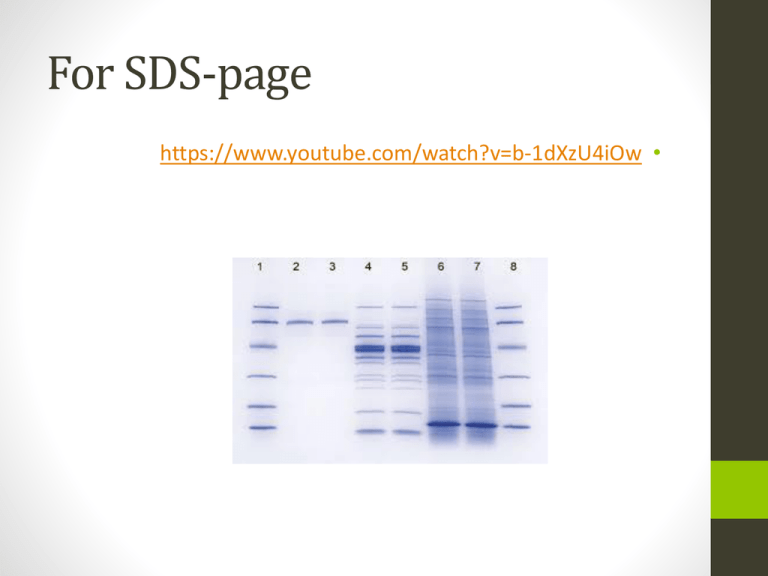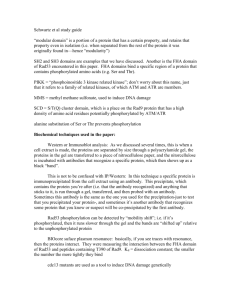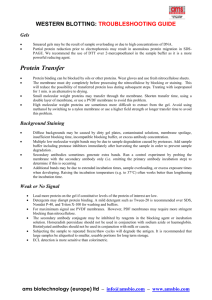Western Blotting
advertisement

For SDS-page https://www.youtube.com/watch?v=b-1dXzU4iOw • Lab#6 Western Blotting BCH 462[practical] Objective: - blotting of proteins from SDS-PAGE. Western blot: -Is used to identify specific antigens[proteins], based on their ability[the antigens] to bind to antibodies. -sometimes called the protein immunoblot Principle: It is an analytical method where in a protein sample is electrophoresed on an SDSPAGE then electro-transferred onto nitrocellulose membrane. The transferred protein is detected using specific primary antibody [1ry-antibody],secondary antibody labeled with an enzyme, and substrate which in the end you will get colored product. The color indicate the presence of the protein of interest. Or First, proteins are separated from each other based on their size[using SDS-PAGE]. Second, antibodies are used to detect the protein of interest. Finally, a substrate that reacts with an enzyme is used to view the antibody/protein complex. Steps of detection of specific protein using Western bolt 1. A protein sample is subjected to polyacrylamide gel electrophoresis. Protein sample SDS-PAGE To confirm the separation of the sample use: 1-Replica of the gel and stain it as usual [with Coomassie brilliant blue R-250] . 2-prestained marker. prestained marker Figure: Protein Ladder is a mixture of nine (9) blue-, orange- and green-stained proteins (10 to 250kDa) for use as size standards in protein electrophoresis (SDS-PAGE) and Western blotting. 2. After that the gel is placed over a sheet of nitrocellulose , the protein in the gel is electrophoretically transferred to the nitrocellulose. “transfer step [Electroblotting]” Membrane [with transferred proteins] Transfer can be done in: 1- wet method. 2-semi-wet method. Because the samples in the gel are [–ev] charged , the applied electric current will facilitate their transferring to nitrocellulose membrane, the samples will move toward the Anode[+]. Also the capillary action has its effect in the movement of the samples from the gel to the nitrocellulose membrane. Note that: [the filter papers, gel and nitrocellulose membrane will soaked in transfer buffer]. 3.The nitrocellulose is then soaked in blocking buffer to block the non-specific binding between the 1ry-antibody and the membrane. And/or non-specific binding between secondary antibodies to the membrane (which has a high capacity at binding proteins and therefore antibodies). Membrane [with transferred proteins] Blocking buffer: To block the nonspecific Binding of proteins. 4.The nitrocellulose is then incubated with the specific primary antibody for the protein of interest. Membrane [with transferred proteins] Specific 1ry antibody [specific for antigen of interest] 5.The nitrocellulose is then incubated with a second antibody, which is specific for the first antibody[1ry –antibody]. Membrane [with transferred proteins +1ry antibody] 2ry antibody [Specific for 1ry antibody] Note that The enzyme linked: will convert colorless substrate to colored product. The color produced indicate the presence of the antibody - antigen [Ab-Ag] binding complex. 6.The second antibody will typically have a covalently attached enzyme which, when provided with a chromogenic substrate, will cause a color reaction. “detection step”. -Alkaline phosphatase (AP) and horseradish peroxidase (HRP) are the two enzymes used most extensively as labels for protein detection. -Several substrates can be converted to colored precipitate “product” by (AP) and (HRP) enzymes. 4CN and TMB are commonly use with (HRP) , Whereas BCIP\NBT is recommended for alkaline phosphatase . As the precipitate accumulate on the membrane, a visible band develops. [P] [S] Colored product Substrate [E] 2ry antibody [Specific for 1ry antibody and linked to an enzyme] Detection of specific protein using Western bolt [P] [S] Colored product Substrate 2ry antibody [Specific for 1ry antibody] Antigen of interest Primary antibody “antibody specified to specific antigen” 7.Thus the molecular weight and amount of the desired protein can be characterized from a complex mixture of proteins by western blotting. Remember: Remember: epitope antigen antibody Remember: enzyme Primary antibody “antibody specified to specific antigen” Secondary antibody “antibody specified to Primary antibody” The enzyme linked: will convert colorless substrate to colored product, Indicate the presence of the antibody antigen [Ab-Ag] binding complex.








